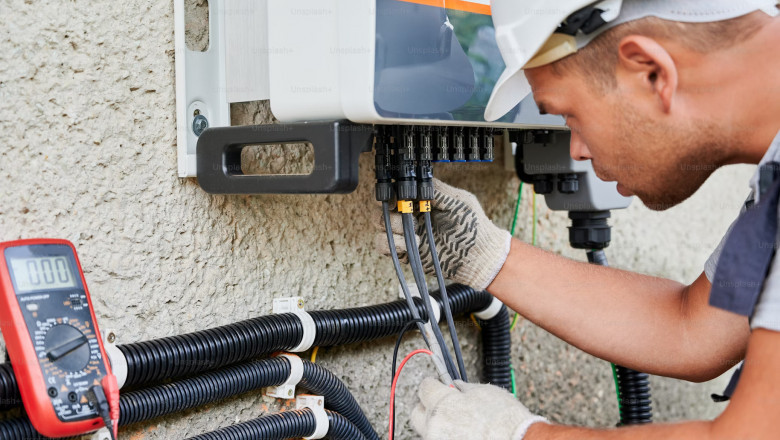views
As solar energy becomes more popular around the world, especially in countries like Pakistan, homeowners are increasingly curious about how solar systems work. One key component—often misunderstood or overlooked—is the solar inverter. While solar panels get all the spotlight, the inverter is the heart of your system.
In this guide, we’ll explore what a solar inverter is, how it works, and why it’s essential. We'll also take a closer look at the role of solar inverters in Pakistan, where rising energy costs and frequent power outages have made solar systems not just beneficial but necessary.
What Is a Solar Inverter?
The Brain Behind the Power
Simply put, a solar inverter is a device that converts the direct current (DC) electricity generated by your solar panels into alternating current (AC) electricity that your home appliances can use.
Since most household devices and the electric grid operate on AC, solar inverters serve as the translator between your solar system and your home. Without it, your solar panels can’t do much on their own. Whether it’s running a fan, charging your phone, or powering your lights, the inverter is what makes solar energy usable in everyday life.
Why Is It So Important?
More Than Just Power Conversion
While converting electricity is its core function, a solar inverter does much more. It monitors your system’s performance, tracks energy production, and often displays valuable data through apps or digital screens. Many inverters now come with smart features, including fault detection, automatic shutdown during emergencies, and connectivity with battery storage.
In Pakistan, where grid outages and voltage fluctuations are common, the role of the inverter becomes even more critical. The growing demand for reliable solar inverters in Pakistan reflects this need. People want systems that are not just functional but resilient and adaptable.
Different Types of Solar Inverters
Choosing the Right Fit for Your System
There are several types of solar inverters, and each serves a different need:
1. String Inverters
These are the most common and cost-effective. One inverter is connected to a series (or "string") of solar panels. However, if one panel is shaded or underperforms, it can affect the whole string.
2. Microinverters
These are installed on each individual solar panel, allowing them to operate independently. They’re more efficient in shaded conditions and provide detailed panel-level monitoring—but at a higher cost.
3. Hybrid Inverters
These work with both solar panels and battery storage. They’re ideal for homes looking to store power and use it during the night or power outages. Hybrid solar inverters in Pakistan are increasingly popular due to frequent load shedding.
4. Central Inverters (for commercial setups)
Used in large-scale installations, these are not common for residential use but are essential in solar farms or industrial plants.
Smart Features That Add Value
Monitoring, Connectivity, and Control
Modern solar inverters do more than just convert power. They offer features that help users better understand and control their energy usage.
Most inverters now come with Wi-Fi or Bluetooth connectivity, allowing users to monitor energy production in real time via mobile apps. These apps provide insights into how much energy you're generating, when you're using the most electricity, and how much you're saving.
For Pakistani consumers, this data is particularly useful. With the fluctuating solar inverters in Pakistan market, these smart tools help you make the most of your investment and alert you early to any issues, ensuring longer system life and reduced maintenance costs.
Common Issues and Maintenance
Keeping Your Inverter Running Smoothly
While solar inverters are generally durable, they do require occasional attention. Dust, heat, and moisture can affect performance—especially in hot and dusty regions of Pakistan. Regular cleaning and visual inspections are usually enough to keep things in top shape.
One common issue is inverter failure due to overheating or component wear. Most inverters last between 10 to 15 years, which means they may need replacement once during the 25-year life of your panels. Choosing quality solar inverters in Pakistan with solid warranties and local support can make a big difference in peace of mind.
The Cost vs. Value Equation
Is It Worth Paying for a Better Inverter?
It’s tempting to cut costs on the inverter and spend more on panels, but that’s not always wise. A low-quality inverter can reduce your system’s overall efficiency, performance, and safety. The right inverter ensures your investment works optimally and lasts longer.
In 2025, the average price of a good-quality 5kW solar inverter in Pakistan ranges between PKR 150,000 to 250,000, depending on brand and features. Although prices vary, the value of having a high-performing inverter cannot be overstated.
Conclusion: A Small Device with a Huge Role
When thinking about solar energy, most people imagine panels catching sunlight. But it’s the solar inverter that actually brings that power into your home and life. It’s the unsung hero—converting, managing, and optimizing every watt of energy.
If you’re investing in solar, make sure to give your inverter the attention it deserves. Choose wisely, maintain it well, and monitor your system regularly. And as the market for solar inverters in Pakistan grows, you’ll find more options that are smarter, more durable, and better suited for local needs.














Comments
0 comment